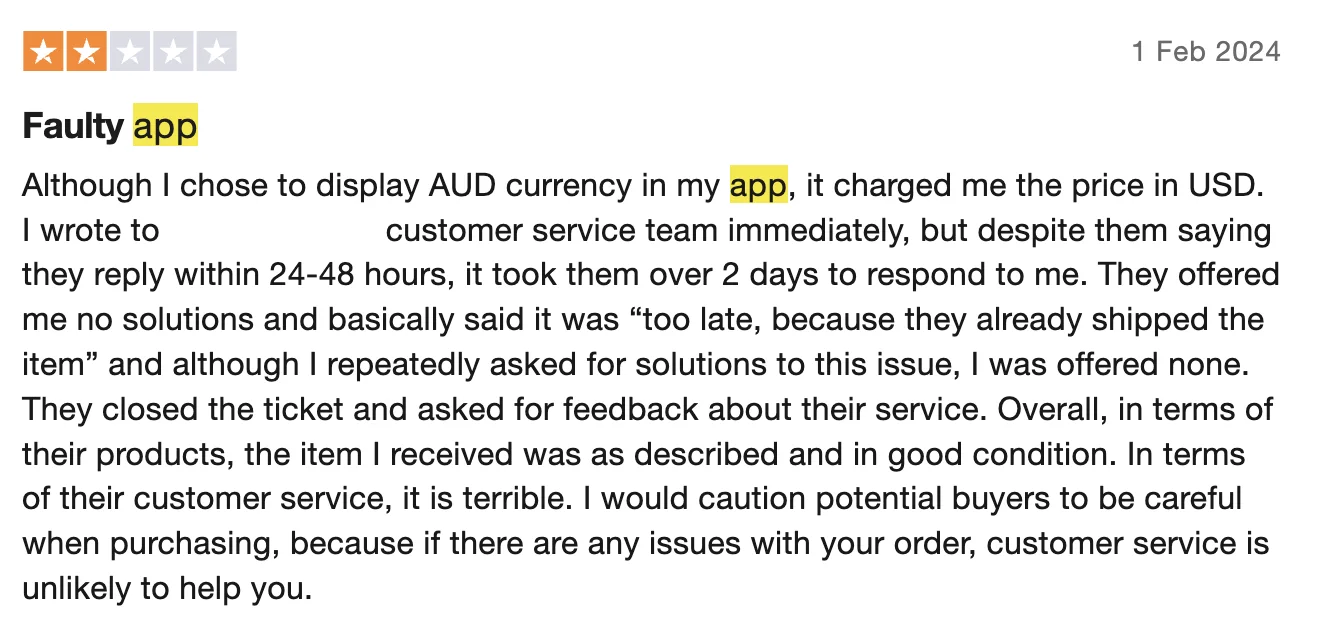
In the last decade, ecommerce has witnessed a boom in demand. Partly thanks to a time when everyone had no choice but to be online.
In total, ecommerce growth is USD 6.3 trillion, a 9.4% increase over the previous year. In Europe, ecommerce growth is expected to increase continuously between 2024 and 2028 by +34.14 %.
What’s next for this segment? There are multiple paths to progress for ecommerce; in 2024, past ecommerce industry trends like omnichannel services and subscription models are holding fast. But augmented reality? That is now nearly the norm. By the end of 2023, there were nearly 1.3 billion Augmented Reality device users worldwide.
Ecommerce trends are something we are keenly aware of at Trustpilot; the consumer side of our business is full of useful insights that help confirm the new ecommerce trends popping up in a busy ecommerce world. In that spirit, we’ve gathered a few trends we think will make the grade for next year's appearance in online shopping, with a few Trustpilot reviews thrown in to support.
1. Mobile is the moment
Our phones are our lifelines. Globally, there are approximately 6.94 billion smartphones, meaning 85% of the population has a mobile phone. It makes sense that ecommerce would take advantage of this fact. In 2023, mobile commerce accounted for 6% of all retail sales, and it’s projected to continue growing; next year, mobile commerce sales will likely hit $710 billion.
Consumers use their mobile devices for more than just purchasing goods and services; they also compare retailers, read reviews, access gift cards and more. It is essential that all B2C ecommerce platforms have a mobile-friendly site. Don’t forget good or bad UX can make or break a sale.

2. Localization is favoured
According to Geotargetly, 75% of users would be more likely to buy from an e-commerce website with localization.
What do we mean by localization? It’s the process of adapting website content for a new region, including translation, associated imagery, and cultural elements. As a global community that is becoming more intertwined online, it is more than necessary to ensure an ecommerce website has that adaptability.
To prepare a site for localization there is internationalization, or when developers allow your website’s codebase to support multiple languages and formats. So, if an Australian citizen visits a US-based website, it will automatically adjust to Australia’s currency, product availability, and delivery services once the country of choice is chosen. But make sure it works smoothly; see an example below.

3. Augmented reality is here to stay
We’ve been talking a lot about AI, but what about Augmented Reality or AR? Online shopping does not always lend itself to an in-store experience, where shoppers can touch, smell and visualize the product much better. A study found that 50% of shoppers are more likely to purchase a piece of furniture if they can see it in their space using their smartphone.
In response to this problem, enter augmented reality or an interactive experience that enhances the real world with computer-generated perceptual information. It’s different from virtual reality or VR in that it isn’t immersive. Companies like Warby Parker allow users to try on glasses virtually or shoes thanks to Amazon’s virtual try-on service.
Another business using augmented reality in its offerings is Lego, with its AR app, which can create smartphone games by scanning static figurines and race tracks under Lego cars.

Image owned by Lego
4. Buy online and pick up in-store is increasing in popularity
Who knew that click-and-collect would be popular in a world where we love a delivery? Buying online and picking up in-store (BOPIS) services offered by most large B2C e-commerce sites will be worth $703.2 billion in 2027. So, what’s the allure of picking up instead of waiting for delivery as we move into 2024?
Some reasons shoppers prefer this method include convenience, immediate satisfaction or sometimes even weather. Consumers crashed the site in the UK when discount retailer Primark introduced their BOPIS service in 2022.
It’s also more appealing to frugal shoppers who don’t want to pay the extra delivery charge for a doorstep service. The same goes for returns. Modern shoppers will likely order additional items online to hit the threshold for free shipping on a purchase.

5. Subscription models are growing
Millennials love a subscription model, and it will continue into the future. A study by Acro Commerce found that 25 to 44-year-olds are most likely to subscribe to a monthly box, streaming or reorder service.
Subscription models will continue to gain momentum because they make great business sense and have become the norm. Acro also found that 35% of active subscribers hold three or more subscriptions.
Ecommerce subscription models will continue to expand and extend beyond online realms. Omnichannel subscription models, like Amazon Prime allow members to enter brick-and-mortar Amazon Fresh stores, pick up produce and leave without encountering a cashier. Amazon CEO Andy Jassy said, “Over time, [the] grocery is going to be omnichannel.”
6. The human touch is back?
While chatbots were once ubiquitous on ecommerce sites, their awkwardness frustrated many consumers. This is reflected in the low acceptance rate of only 34% among retail consumers. But does that mean no more chatbots? Not quite.
Despite the hiccups, there's still considerable potential in chatbots, and the mass adoption of this feature proves it. Investment remains strong, with projected global retail spending via chatbots hitting $142 billion this year. They offer convenience for tasks like reservations and quick purchases.
The human touch remains crucial. Mintel points out that “consumers will increasingly seek out uniquely human elements in contrast to faceless algorithms.”
So, where does this leave chatbots in 2024? They will need to keep evolving. The key lies in a hybrid approach. Ecommerce companies can leverage technology like AI and chatbots for efficient solutions, but they must prioritize seamless human experience when needed.

7. Social commerce will continue to rise
TikTok Shop, Instagram Shop, Pinterest Shop, and Facebook Marketplace are all examples of how social commerce is making its mark.
The combination of social media and shopping has been around for a while, but we saw an uplift that continues into this year– 60% of Gen-Z shoppers turn to social media for information. The ability to sell on instragram is also easier than ever, with 90% of users following at least one brand.
Despite its worldwide appeal, there is an issue with trust around social commerce sales. According to Hubspot, 54% of consumers are concerned about the legitimacy of companies selling on social media.
8. Voice search will be used more in shopping
Over 142 million individuals utilize voice search technology, which is growing in popularity for online shoppers. Voice search functions by converting spoken words into text through automatic speech recognition (ASR) software.
Voice search is gold for online retailers due to its wealth of data, especially in analyzing the intent behind longer voice searches. This offers a better grasp of consumer preferences, improving the shopping experience.
9. Privacy and transparency will reign supreme
Consumers are less willing to offer up a significant amount of their personal information, especially when they don’t know how it’s used.
In Europe, ecommerce companies are banned from capturing third-party data without permission. This will lead to more retailers offering opt-out measures on their websites so consumers feel more in control of their online shopping experience.
In the United States, five new privacy laws were introduced in 2023, with one state-based law in California providing consumers with private right of action (the ability to sue offenders in the event of a data breach or other violation).
Key takeaways
Consumers increasingly use mobile devices for shopping, expected to continue with sales reaching $710 billion in 2024.
Businesses must adapt their websites and content for different regions to cater to customer preferences and comply with regulations.
AR technology allows customers to virtually try on products or see them in their own spaces, enhancing the online shopping experience.
BOPIS offers convenience and immediate satisfaction, and its popularity is expected to grow.
Consumers, especially millennials, are drawn to the convenience and variety of subscription services.
While still valuable for tasks like reservations, chatbots need to be improved and integrated with a seamless human experience.
Platforms like TikTok Shop and Instagram Shop make social media a key shopping destination, but trust remains an issue.
This technology allows for convenient, hands-free shopping and provides valuable data for retailers.
Consumers are increasingly concerned about data privacy, and businesses must be transparent about collecting and using data.
Interested in reading more about our views on ecommerce? Click here for more insights.



